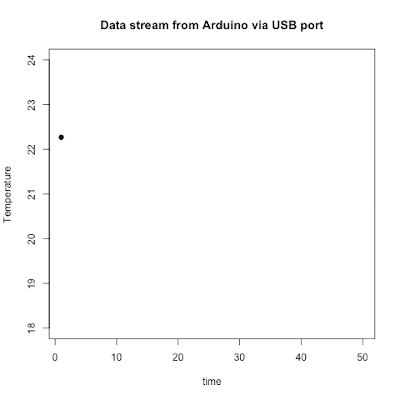scan function. Here is my temperature sensor example again:
And all it needs to read the signal into the R console with my computer is:
> f <- file("/dev/cu.usbmodem3a21", open="r")
> scan(f, n=1)
Read 1 item
[1] 20.8
> close(f)Note: This worked for me on my Mac and I am sure it will work in a very similar way on a Linux box as well, but I am not so sure about Windows. Crucially, I had to learn the difference between the tty* and cu* devices. I found the following statement in Mike's PBX Cookbook particular insightful:
You might notice that each serial device shows up twice in /dev, once as a tty.* and once as a cu.*. So, what's the difference? Well, TTY devices are for calling into UNIX systems, whereas CU (Call-Up) devices are for calling out from them (eg, modems). We want to call-out from our Mac, so /dev/cu.* is the correct device to use.You find the file address of your Arduino by opening the Arduino software and looking it up under the menu Tools > Port.
With a little more R code I can create a 'live' data stream plot of my Arduino.
 |
| Reload this page to see the animated Gif again. |
R code
Here is the original Arduino sketch as well:
Session Info
R version 3.1.2 (2014-10-31)
Platform: x86_64-apple-darwin13.4.0 (64-bit)
locale:
[1] en_GB.UTF-8/en_GB.UTF-8/en_GB.UTF-8/C/en_GB.UTF-8/en_GB.UTF-8
attached base packages:
[1] stats graphics grDevices utils datasets methods
[7] base
loaded via a namespace (and not attached):
[1] tools_3.1.
0 Response to "Reading Arduino data directly into R"
Post a Comment